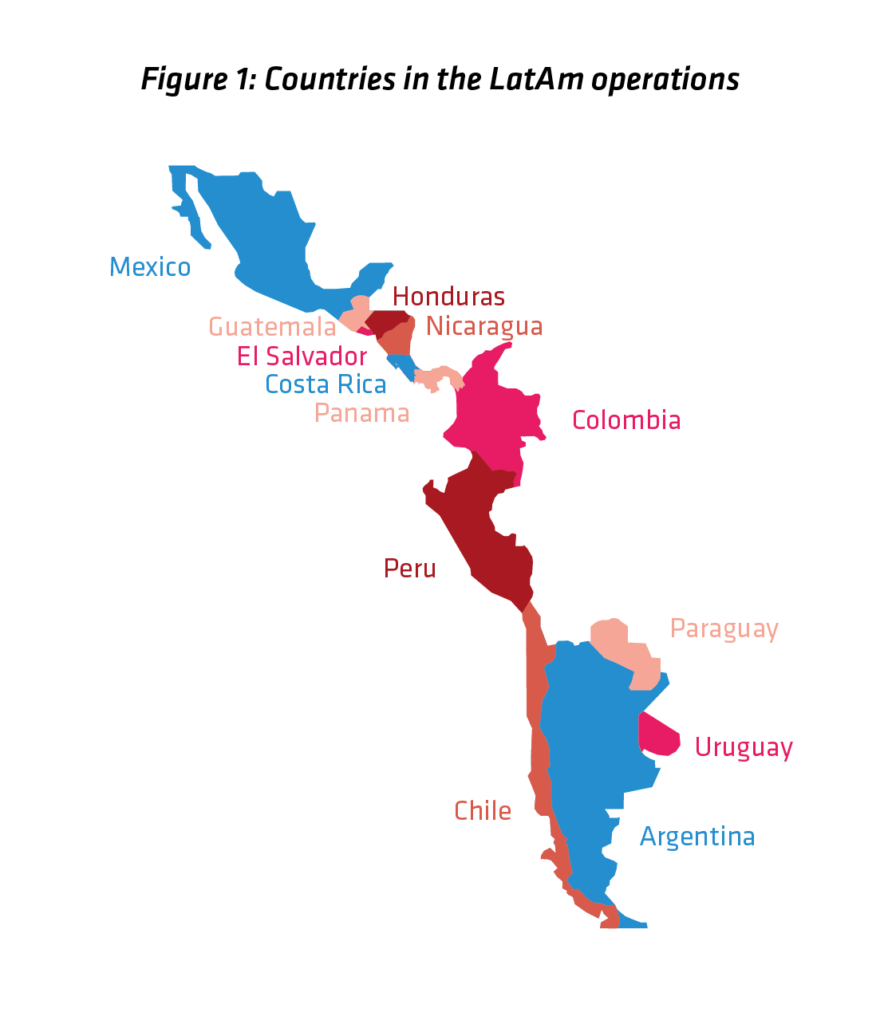Introduction
Last week I received an email from Mark Lisso, VP of Strategy for the Americas, which he had copied the whole of the Americas and LatAm/Brazil management team at thyssenkrupp Elevators (tkE), concluding the well-executed incorporation of the entire operation of Latin America into the Brazilian Shared Service Centre (SSC). The email was a response to the leaders in this journey, Fabiane Sum, Daniel Santanna and Reynaldo Moreira, who informed him that Chile, the last of the 13 countries and the biggest operation, had been incorporated into the service centre that month. Reading that email, it didn’t seem that two years had gone by since that day when we stepped into the LatAm headquarters in Santiago do Chile at the start of this endeavour.
Background
To tell this story, we need to quickly look back at the tkE SSC in Brazil. Implemented in 2010, covering a wide range of macro-processes and with over 200 employees, that SSC enabled tkE Brazil to achieve one of the best financial results across all of the Elevators Technology operations in the Group, coming to be recognised as being global best practice. Meanwhile, the operation of the neighbouring tkE LatAm, covering 13 Spanish-speaking countries, showed EBIT KPIs on sales six times lower (as %EBIT) than that for Brazil. In this context, the previous Brazil CFO took over the role of CEO LatAm with the objective of making that operation profitable, bringing the %EBIT up to the minimum global level. The new CEO, Felipe Condessa, found a region with a maturity that was at least 10 years behind that of the Brazilian operation: disaggregated systems, different practices between countries, as well as several manual processes such as receivables and cash payments. To produce scale and control the operation, Condessa kicked off the LatAm SSC project.
Planning and Business Case
In August 2015, we arrived at the LatAm headquarters in Santiago do Chile to begin the feasibility study and process scope analysis, the scaling of the centre and development of the implementation plan through a structured business case. For that, the operations of six countries were witnessed and mapped in 12 weeks, among them a few smaller countries like Guatemala and Panama, and big ones such as Chile and Colombia. Those analyses were made in light of the Brazilian SSC practices. However, not all of those could be transferred to the LatAm design.


The level of banking maturity in some countries is so low that parts of the process had to be defined such that they remained in the country, such as the issuing of invoices and cheque collection. As well as the SSC, other initiatives would be initiated in parallel to increase process maturity, and the SSC would be a beneficiary of those.
In this planning, the processes that would be centralised in Finance (bills to pay, receipts, accounting and reporting), Procurement (purchasing and importation) and Back Office (pricing and contract registry) were all defined. As well as those, a study was conducted to locate the centre. Even though some LatAm countries, such as Colombia, presented a low cost base, Brazil was chosen for the implementation given the synergy with the Brazilian SSC. The benefits of being able to rely on the experience of those who already worked in that SSC, even with a potentially more expensive operation, outweighed the risks of a fresh implementation in another country. Having approved the centre’s implementation, we started the internationalisation of tkE’s Brazilian SSC in Porto Alegre in January 2016.
Preparation
To implement the LatAm processes in the Brazil SSC, we opted to engender a sequence of countries, bringing all the processes of a country across in one go. To begin with, we identified a pilot country where we could work on the detail before going on to incorporate the other countries. We chose Uruguay as it was a small operation, relatively under control and principally because of its proximity to Porto Alegre. Because of that proximity, we would be able to take SSC managers to Montevideo or take employees from Montevideo to Porto Alegre quickly and cheaply.
For that, before starting the incorporation, we prepared for three months, designing the procedures in detail, defining the personnel contracting plan, developing a workflow system and setting up the telephony platform. Even though the ERP system was the same for the LatAm countries, the system architecture was fragmented by country, making centralization of its management impossible. Because of that, we had to create a single interface for inbound calls, enabling the sharing of teams and queue handling.
Our objective was to define process cells in which the same person could execute a transaction for whichever country, independent of the ERP “version”. The way to achieve this was through the unified workflow system, even though the user would have to log in to that country’s ERP in a disaggregated manner. As for telephony, a solution based on an Embratel link would take three months. As in the improvements to the ERP system, implementing the workflow and setting up the telephony system, our strategy was to not wait for the perfect solution. To meet the project schedule, we began the incorporation of Uruguay’s operations with simplified versions of the final technology platform design. For example, we used a single, generic workflow before the various specific versions, using Skype for telephone communications and using the “as is” interface to access the ERP. The most robust scenario came a few months later proving that the SSC model was succeeding.
Another important activity that began during those first three months and which continued throughout the implementation that the formation of the LatAm operations team. As with the implementation strategy, the team was built to support the LatAm operations in a dedicated manner, without synergy from the Brazilian cells. The teams only shared their leadership. This strategy was adopted taking into consideration that the process maturity levels in Brazil and LatAm were so distinct and a full integration model could introduce risks to the operations in the first instance.
The LatAm cells have requirements for proficiency in Spanish as well as an appreciation of the cultural issue inherent to a global SSC. Finding resources who could meet those requirements in the market was a risk identified in the business case. Different actions were taken to secure them: the use of specialized recruitment agencies, the establishment of partnerships with foreign consulates in Brazil and transferring tkE employees to Porto Alegre.
Incorporations
Following the conclusion of the pilot in Uruguay, an intense rhythm was set to bring one country to the SSC per month while our change management plan was put into practice. Each country was mapped singly one month ahead of its inclusion and conceptual presentations for the SSC were given to its leadership team. Based on this individual country mapping, we designed the future personnel structure for the country and the timeline for redundancies. For two weeks, one before the country’s “go live” and one after, part of the project team based itself in that country to carry out training and support assisted operations.
After Uruguay, we faced a journey to incorporate eight operations. Following five of those, a period of stabilization took place for two months. This strategy was successful as it allowed the SSC internal teams to recover, for the processes to be amended to those of a large scale of operation and for training to be given again to the already incorporated countries.
During the implementation, we learnt that the northern tkE operations, such as Mexico and Central America, were very open to change but needed the repetition of training to guarantee correct process execution. The southern operations of Argentina and Uruguay, on the other hand, resulted in bigger conflicts as they questioned the new processes far more.
One highlight during the incorporations was the Panama operation. Before its inclusion in the SSC, Panama has undergone a significant restructuring, with changes in the country leadership team and many operational roles. Panama, the third country to be included, embraced the SSC concept and used it to leverage the restructure, achieving excellent financial results in a short time.
Examples from the Panamanian process execution were used at various points in the other operations as good practice.
End Results
Following nearly two years from the start of the business case, Porto Alegre today has all of Latin America in-house. We carry out 12,000 transactions per month with a team of 75 people. Throughout the implementation, execution, financial and service level indicators were closely monitored, with the result that the financial accounts for the period of the implementation came in at 97% of the projected budget in the business case. Moreover, the last country, Chile, was implemented within the forecasted period. In the last month of the project, the service level agreements and transaction costs were established for the whole of LatAm via the SSC Internal Clients Committee, which brought together the leaders of four of the incorporated countries.
It was a long journey to get here. We now have a completely integrated continent, with solid bases for even more daring projects that will bring the profitability of LatAm to the thyssenkrupp Elevators Technology global levels.


Figure 2: Meeting of the LatAm Client Committee to define SLA and Transaction Costs
About the authors
Breno Jácome, managing partner of Visagio, has over 15 years of experience in consultancy projects of organizational redesign, business process reengineering, logistics and supply chain and PMO/change management. Has experience in a broad range of industries such as consumer goods, retail, services, mining and insurance and different countries such as Brazil, Chile, Peru, Germany, France and Spain. He has specialization in logistics management by COPPEAD/UFRJ.
Lucas Felix is Senior Consultant at Visagio. With experience in organizational restructuring, shared service center implementation and operations turn around, has done projects for clients in industries such as oil and gas, consumer goods, professional services and agrobusiness. In Visagio, he has worked in more them 10 different countries such as Brazil, Argentina, Chile, Peru, Guatemala and Russia.
Fernanda Becker is a consultant at Visagio with experience in zero based-budget projects, shared services implementation and transformations of the commercial workforce.
Fabiane Sum is Project Manager at thyssenkrupp Elevators Brazil.
Daniel Santanna is Manager of the Shared Service Center at thyssenkrupp Elevators Brazil.


